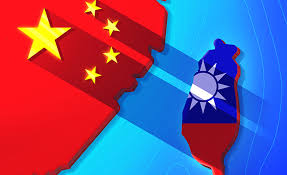by Martin Haffner Associate Editor
In a stark warning reflecting the escalating tensions across the Taiwan Strait, China’s military has declared its intent to tighten the “noose” around Taiwan should separatist sentiments on the island grow. This announcement underscores the Chinese government’s unwavering stance against any moves toward independence by Taiwan, which it considers a breakaway province.
The statement from China’s People’s Liberation Army (PLA) comes in the wake of heightened military activities near Taiwan, including frequent air and naval exercises that have raised alarms within the international community. These maneuvers are interpreted as rehearsals for potential military action, aimed at demonstrating China’s capability and resolve to assert its claims over Taiwan.
For years, China has maintained a policy of “One China,” which asserts that there is only one sovereign state under the name China, including Taiwan, and it views any moves toward Taiwanese independence as a direct threat to its sovereignty. The recent rhetoric from the PLA reflects a more aggressive posture, highlighting Beijing’s increasing intolerance for perceived separatism and its readiness to respond with military force if necessary.
Taiwan’s government, led by President Tsai Ing-wen, has consistently rejected the notion of unifying with China under its terms. Instead, Taiwan has sought to assert its identity and maintain its autonomy, garnering international support in the process. Taiwan’s defense officials have voiced concerns over China’s military activities and emphasized the need to bolster the island’s defense capabilities in the face of increasing pressure.
In a resilient show of national spirit, Taiwan has pledged to enhance its military preparedness and strengthen alliances with global partners, particularly the United States, which has a longstanding commitment to assist Taiwan in maintaining its self-defense capabilities.
The situation in the Taiwan Strait holds significant global implications, particularly for regional stability and security. The United States has reiterated its support for Taiwan, emphasizing the importance of peace and stability in the region. U.S. officials have warned against any unilateral attempts by China to alter the status quo, underscoring America’s commitment to the Taiwan Relations Act, which facilitates arms sales and military support for Taiwan.
The international community is increasingly raising concerns about China’s assertiveness, with calls for a diplomatic resolution to the cross-strait tensions. As military posturing intensifies, many worry about the potential for miscalculation leading to armed conflict, which could have far-reaching repercussions for the region and beyond.
The path forward remains fraught with uncertainty, as geopolitical dynamics shift and tensions continue to mount. Maintaining open lines of communication and pursuing diplomatic channels will be crucial in preventing an escalation of conflict. Both Taiwan and China must balance their respective national interests while navigating the complexities of sovereignty, regional relations, and international law.
As China’s military warns of tightening the “noose” around Taiwan, the island finds itself at a crossroads—caught between a growing regional power and its desire for greater autonomy and recognition on the world stage. The response from Taiwan, coupled with international support, will play a critical role in shaping the future of cross-strait relations and maintaining stability in the Asia-Pacific region.
The declaration from China’s military serves as a stark reminder of the fragile status quo in the Taiwan Strait. As tensions rise and the prospect of conflict looms, the need for dialogue and collaboration is more pressing than ever. The international community must remain vigilant and committed to ensuring that peace and stability prevail, fostering an environment where negotiation and understanding can triumph over confrontation and hostility.



